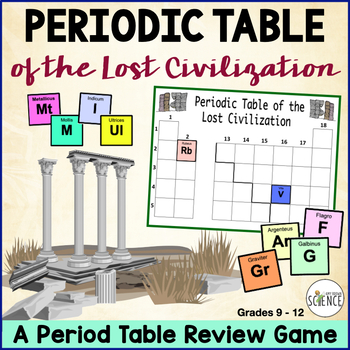Periodic Table Review Game - Periodic Trends Activity
- Zip
- Google Apps™

What educators are saying
Description
This periodic table review game will test your student's knowledge of periods and families, periodic trends, valence shells and electrons, electronegativity, atomic radius, atomic numbers, mass numbers, ionization energy, and the location of metals and nonmetals. This fun and interactive review game will ensure that your students understand the relationships and periodic properties of the elements on the periodic table.
Printable and Digital Versions:
Both printable (editable) and digital versions of this resource are included. The student handouts can be printed or used in the paperless digital format in your Google Drive, Google Classroom, Microsoft OneDrive, or similar. The printable version is editable so that you can make this activity a perfect fit for your students.
This resource is perfect for traditional classroom settings, 1:1 schools, or for distance learning.
Introduction of the Game: A long lost civilization has been found buried beneath many feet of lava from an ancient volcanic eruption. The population consisted of many scientists who were in the early stages of discovering and identifying the elements of the natural world. Stone tablets were recovered from beneath the lava showing that these ancient scientists were in the process of developing a periodic table of the elements known to them. Can your students use the clues to decipher this ancient periodic table?
What will the students be doing?
The ancient population had different names and symbols for the elements than those used on the modern day periodic table. Students must decipher the clues and descriptions of each element in order to place the elements in the correct position on the periodic table.
What is included in your download folder?
- Period Table Game Board PDF
- Element Squares PDF
- Printable and Editable Student Handouts (4-page Student Worksheet with 49 analysis questions)
- Digital paperless version for use in Google Drive, Google Classroom, and/or Microsoft OneDrive
- Google Slides Version (not editable)
- Teacher Guide and Answer Key
- Teacher Guide to Google Apps
PLEASE NOTE: In order to complete this activity students must have background knowledge about the following concepts:
- Periods and Families
- Electronegativity
- Ionization energy
- Atomic radius
- Valence shells and valence electrons
- Metals, nonmetals and semimetals
- Atomic number and atomic mass
❤️ TEACHERS LIKE YOU SAID: ❤️
⭐️⭐️⭐️⭐️⭐️ "Creative and fun resource for my students! Engaging and motivational for all learners, even my more reluctant ones! Thanks so much!"
⭐️⭐️⭐️⭐️⭐️ "Great activity! My students enjoyed it and it really challenged them to integrate all the information we learned about the periodic table."
⭐️⭐️⭐️⭐️⭐️ "This was a wonderful way to reinforce periodic trends. The students were engaged and thinking through the whole activity."
Related products include:
Periodic Table Scavenger Hunt Review
Periodic Table St. Patrick's Day Hidden Picture Review Activity
Activity: Trends on the Periodic Table
Periodic Table Homework and Study Guide
Periodic Table Review and Practice Problem Worksheet
FREE Table of Electronegativities for Chemical Bonding Unit
For updates about sales and new products, please follow my store:





